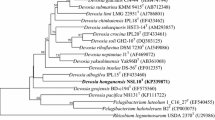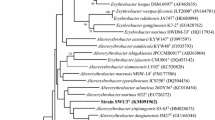Abstract
A novel Gram-negative, motile, rod-shaped, facultative anaerobic bacterial strain, KMK6T, was isolated from soil contaminated with textile dyes from an industrial estate located at Ichalkaranji, Maharashtra, India, and its taxonomical position was established by using a polyphasic approach. The major cellular fatty acids included C17:1ω8c, summed feature 3 (C16:1ω7c and/or iso-C15:0 2-OH), C17:0, C16:0, and C18:1ω7c. The DNA G+C content of strain KMK6T was 48.8 mol %. 16S rRNA gene sequence analysis confirmed its placement in the genus Alishewanella, and exhibited sequence similarity levels of below 97 % to the type strains of validly published Alishewanella species. On the basis of genotypic and phenotypic evidence, strains KMK6T is considered to be a novel species of the genus Alishewanella, for which we propose that strain KMK6T (=NCIM 5295T =BCRC 17848T) is assigned to a novel species, Alishewanella solinquinati sp. nov.



Similar content being viewed by others
References
Chun J, Lee JH, Jung Y, Kim M, Kim S, Kim BK, Lim YW (2007) EzTaxon: a web-based tool for the identification of prokaryotes based on 16S ribosomal RNA gene sequences. Int J Syst Evol Microbiol 57:2259–2261
CLSI (2003). Performance Standards for Antimicrobial Disk Susceptibility Tests, 8th edn. Approved Standard M2–A8. Wayne, PA: Clinical Laboratory Standards Institute
De Ley J, Cattoir Reynaerts A (1970) The quantitative measurement of DNA hybridization from renaturation rates. Eur J Biochem 12:133–142
Felsenstein J (1985) Confidence limits on phylogenies: an approach using the bootstrap. Evolution 39:783–791
Huss VAR, Festl H, Schleifer KH (1983) Studies on the spectrophotometric determination of DNA hybridization from renaturation rates. Syst Appl Microbiol 4:184–192
Kim MS, Roh SW, Nam YD, Chang HW, Kim KH, Jung MJ, Choi JH, Park EJ, Bae JW (2009). Alishewanella jeotgali sp. nov., isolated from traditional fermented food, and emended description of the genus Alishewanella. Int J Syst Evol Microbiol 59:2313–2316
Kim MS, Jo SK, Roh SW, Bae JW (2010) Alishewanella agri sp. nov., isolated from landfill soil. Int J Syst Evol Microbiol 60:2199–2203
Kimura M (1980) A simple method for estimating evolutionary rate of base substitutions through comparative studies of nucleotide sequences. J Mol Evol 16:111–120
Kimura M (1983) The neutral theory of molecular evolution. Cambridge University Press, Cambridge
Kroppenstedt RM (1985) Fatty acid and menaquinone analysis of actinomycetes and related organisms. In: Goodfellow M (ed) Chemical methods in bacterial systematics. Academic Press, New York, pp 173–199
Li WJ, Xu P, Schumann P, Zhang YQ, Pukall R, Xu LH, Stackebrandt E, Jiang CL (2007) Georgenia ruanii sp. nov., a novel actinobacterium isolated from forest soil in Yunnan (China) and emended description of the genus Georgenia. Int J Syst Evol Microbiol 57:1424–1428
Marmur J, Doty P (1962) Determination of the base composition of deoxyribonucleic acid from its thermal denaturation temperature. J Mol Biol 5:109–118
Meier A, Kirschner P, Schröder KH, Wolters J, Kroppenstedt RM, Böttger EC (1993) Mycobacterium intermedium sp. nov. Int J Syst Bacteriol 43:204–209
Mesbah M, Whitman WB (1989) Measurement of deoxyguanosine/thymidine ratios in complex mixtures by high-performance liquid chromatography for determination of the mole percentage guanine + cytosine of DNA. J Chromatogr 479:297–306
Minnikin DE, O’Donnell AG, Goodfellow M, Alderson G, Athalye M, Schaal A, Parlett JH (1984) An integrated procedure for the extraction of isoprenoid quinones and polar lipids. J Microbiol Methods 2:233–241
Mogensen GL, Kjeldsen KU, Ingvorsen K (2005) Desulfovibrio aerotolerans sp. nov., an oxygen tolerant sulphate reducing bacterium isolated from activated sludge. Anaerobe 11:339–349
Roh SW, Nam YD, Chang HW, Kim KH, Kim MS, Oh HM, Bae JW (2009) Alishewanella aestuarii sp. nov., isolated from tidal flat sediment and emended description of the genus Alishewanella. Int J Syst Evol Microbiol 59:421–424
Saitou N, Nei M (1987) The neighbour-joining method: a new method for reconstructing phylogenetic trees. Mol Biol Evol 4:406–425
Sasser M (1990). Identification of bacteria by gas chromatography of cellular fatty acids, MIDI technical note 101. Newark: DE: MIDI Inc
Smibert RM, Krieg NR (1994) Phenotypic characterization. In: Gerhardt P, Murray RGE, Wood WA, Krieg NR (eds) Methods for general and molecular bacteriology. American Society for Microbiology, Washington, DC, pp 607–655
Stackebrandt E, Ebers J (2006) Taxonomic parameters revisited: tarnished gold standards. Microbiol Today 33:152–155
Stackebrandt E, Goebel BM (1994) Taxonomic note: a place for DNA–DNA reassociation and 16S rRNA sequence analysis in the present species definition in bacteriology. Int J Syst Bacteriol 44:846–849
Tamura K, Dudley J, Nei M, Kumar S (2007) MEGA4: molecular evolutionary genetics analysis (MEGA) software version 4.0. Mol Biol Evol 24:1596–1599
Thompson JD, Gibson TJ, Plewniak F, Jeanmougin F, Higgins DG (1997) The CLUSTAL_X windows interface: flexible strategies for sequence alignment aided by quality analysis tools. Nucleic Acids Res 25:4876–4882
Tarhriz V, Nematzadeh G, Zununi Vahed S, Hejazi MA, Hejazi MS (2012) Alishewanella tabrizica sp. nov., isolated from Qurugöl Lake. Int J Syst Evol Microbiol 62:1986–1991
Vogel BF, Venkateswaran K, Christensen H, Falsen E, Christiansen G, Gram L (2000) Polyphasic taxonomic approach in the description of Alishewanella fetalis gen. nov., sp. nov., isolated from a human foetus. Int J Syst Evol Microbiol 50:1133–1142
Wayne LG, Brenner BJ, Colwell RR, Grimon PAD, Kandler O, Krichevsky MI, Moore LH, Moore WEC, Murray RGE, Stackebrandt E, Starr MP, Truper HG (1987) Report of the ad hoc committee on reconciliation of approaches to bacterial systematics. Int J Syst Bacteriol 37:463–464
Acknowledgments
The author Y. M. K. thanks to the University Grants Commission (UGC), New Delhi for the research fellowship. We thank Dr. Elke Lang, DSMZ, Germany for her support in the course of the work and for providing the Alishewanella aestuarii DSMZ 19476T required for our study.
Author information
Authors and Affiliations
Corresponding author
Rights and permissions
About this article
Cite this article
Kolekar, Y.M., Pawar, S.P., Adav, S.S. et al. Alishewanella solinquinati sp. nov., Isolated from Soil Contaminated with Textile Dyes. Curr Microbiol 67, 454–459 (2013). https://doi.org/10.1007/s00284-013-0385-7
Received:
Accepted:
Published:
Issue Date:
DOI: https://doi.org/10.1007/s00284-013-0385-7




